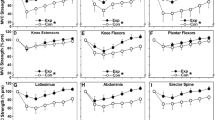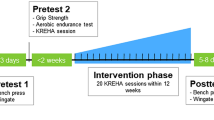Abstract
The number of eccentric contractions is a factor affecting the magnitude of muscle damage; however, it is unknown whether set-repetition configurations for the same total number of eccentric contractions affect the muscle damage. The present study investigated whether different set-repetition configurations would result in different force output during eccentric exercise and different magnitude of muscle damage following the first and second exercise bouts. Ten non-resistance-trained men (26.1 ± 4.1 years) performed two bouts of eccentric exercise of the elbow flexors of each arm (4 bouts in total). One arm performed 3 sets of 10 maximal eccentric contractions (3 × 10) and the contralateral arm performed 10 sets of 3 maximal eccentric contractions (10 × 3), and each arm performed 20 sets of 3 maximal eccentric contractions (20 × 3) 4 weeks after the first bout. The order of the exercise (3 × 10, 10 × 3) and the use of arm (dominant, non-dominant) were counterbalanced amongst subjects. The torque produced over 30 eccentric contractions was similar between 3 × 10 and 10 × 3, and the changes in torque during 20 × 3 were similar between arms. Maximal voluntary contraction strength, range of motion, biceps brachii cross-sectional area and muscle soreness changed significantly (P < 0.05) following the exercise without significant differences between 3 × 10 and 10 × 3, and changes in the measures following 20 × 3 were similar between arms, except for range of motion (ROM). No significant difference in the changes in any measures except ROM was evident when compared between the first and second bouts. These results showed that changing the set-repetition configuration had little effect on muscle damage.





Similar content being viewed by others
References
Baechle TR, Earle RE, Wathen D (2008) Resistance training. In: Essentials of strength training and conditioning/national strength and conditioning association. 3rd edn. Human Kinetics, Champaign, pp 382–412
Chapman DW, Newton M, McGuigan MR, Nosaka K (2008) Comparison between old and young men for responses to fast velocity maximal lengthening contractions of the elbow flexors. Eur J Appl Physiol 104:531–539
Chen TC, Nosaka K (2006) Effects of number of eccentric muscle actions on first and second bouts of eccentric exercise of the elbow flexors. J Sci Med Sport 9:57–66
Chen TC, Nosaka K, Sacco P (2007) Intensity of eccentric exercise, shift of optimum angle, and the magnitude of repeated-bout effect. J Appl Physiol 102:992–999
Child RB, Saxton JM, Donnelly AE (1998) Comparison of eccentric knee extensor muscle actions at two muscle lengths on indices of damage and anglespecific force production in humans. J Sports Sci 16:301–308
Chleboun GS, Howell JN, Conatser RR, Giesey JJ (1998) Relationship between muscle swelling and stiffness after eccentric exercise. Med Sci Sports Exerc 30:529–535
Clarkson PM, Sayers SP (1999) Etiology of exercise-induced muscle damage. Can J Appl Physiol 24:234–248
Clarkson PM, Tremblay I (1988) Exercise-induced muscle damage, repair, and adaptation in humans. J Appl Physiol 65:1–6
Deighan M, De Ste Croix M, Grant C, Armstrong N (2006) Measurement of maximal muscle cross-sectional area of the elbow extensors and flexors in children, teenagers and adults. J Sports Sci 24:543–546
Falvo MJ, Schilling BK, Bloomer RJ, Smith WA, Creasy AC (2007) Efficacy of prior eccentric exercise in attenuating impaired exercise performance after muscle injury in resistance trained men. J Strength Cond Res 21:1053–1060
Falvo MJ, Schilling BK, Bloomer RJ, Smith WA (2009) Repeated bout effect is absent in resistance trained men: an electromyographic analysis. J Electromyogr Kines 19:529–535
Howatson G, Van Someren K, Hortobagyi T (2007) Repeated bout effect after maximal eccentric exercise. Int J Sports Med 28:557–563
Lau WY, Nosaka K (2011) Effect of vibration treatment on symptoms associated with eccentric exercise-induced muscle damage. Am J Phys Med Rehabil 90:648–657
Lavender AP, Nosaka K (2006) Changes in fluctuation of isometric force following eccentric and concentric exercise of the elbow flexors. Eur J Appl Physiol 96:235–240
Lavender AP, Nosaka K (2008) A light load eccentric exercise confers protection against a subsequent bout of more demanding eccentric exercise. J Sci Med Sport 11:291–298
McHugh MP (2003) Recent advances in the understanding of the repeated bout effect: the protective effect against muscle damage from a single bout of eccentric exercise. Scand J Med Sci Sports 13:88–97
Nosaka K, Newton M (2002) Difference in the magnitude of muscle damage between maximal and submaximal eccentric loading. J Strength Cond Res 16:202–208
Nosaka K, Sakamoto K, Newton M, Sacco P (2001) The repeated bout effect of reduced-load eccentric exercise on elbow flexor muscle damage. Eur J Appl Physiol 85:34–40
Nosaka K, Newton MJ, Sacco P (2005) Attenuation of protective effect against eccentric exercise-induced muscle damage. Can J Appl Physiol 30:529–542
Raastad T, Owe SG, Paulsen G, Enns D, Overgaard K, Crameri R, Kiil S, Belcastro A, Bergersen L, Hallen J (2010) Changes in calpain activity, muscle structure, and function after eccentric exercise. Med Sci Sports Exerc 42:86–95
Ratamess NA, Alvar BA, Evetoch TK, Housh TJ, Kibler WB, Kraemer WJ, Triplett NT (2009) American college of sports medicine position stand. Progression models in resistance training for healthy adults. Med Sci Sports Exerc 41:687–708
Schoenfeld BJ (2010) The mechanisms of muscle hypertrophy and their application to resistance training. J Strength Cond Res 24:2857–2872
Smith IC, Newham DJ (2007) Fatigue and functional performance of human biceps muscle following concentric or eccentric contractions. J Appl Physiol 102:207–213
Zainuddin Z, Sacco P, Newton M, Nosaka K (2006) Light concentric exercise has a temporary analgesic effect on delayed-onset muscle soreness, but no effect on recovery from eccentric exercise. Appl Physiol Nutr Metab 31:126–134
Author information
Authors and Affiliations
Corresponding author
Additional information
Communicated by Susan A. Ward.
Rights and permissions
About this article
Cite this article
Chan, R., Newton, M. & Nosaka, K. Effects of set-repetition configuration in eccentric exercise on muscle damage and the repeated bout effect. Eur J Appl Physiol 112, 2653–2661 (2012). https://doi.org/10.1007/s00421-011-2247-y
Received:
Accepted:
Published:
Issue Date:
DOI: https://doi.org/10.1007/s00421-011-2247-y




